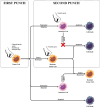Senolytics: charting a new course or enhancing existing anti-tumor therapies?
- PMID: 39633108
- PMCID: PMC11996976
- DOI: 10.1007/s13402-024-01018-5
Senolytics: charting a new course or enhancing existing anti-tumor therapies?
Abstract
Cell senescence is a natural response within our organisms. Initially, it was considered an effective anti-tumor mechanism. However, it is now believed that while cell senescence initially acts as a robust barrier against tumor initiation, the subsequent accumulation of senescent cells can paradoxically promote cancer recurrence and cause damage to neighboring tissues. This intricate balance between cell proliferation and senescence plays a pivotal role in maintaining tissue homeostasis. Moreover, senescence cells secrete many bioactive molecules collectively termed the senescence-associated secretory phenotype (SASP), which can induce chronic inflammation, alter tissue architecture, and promote tumorigenesis through paracrine signaling. Among the myriads of compounds, senotherapeutic drugs have emerged as exceptionally promising candidates in anticancer treatment. Their ability to selectively target senescent cells while sparing healthy tissues represents a paradigm shift in therapeutic intervention, offering new avenues for personalized oncology medicine. Senolytics have introduced new therapeutic possibilities by enabling the targeted removal of senescent cells. As standalone agents, they can clear tumor cells in a senescent state and, when combined with chemo- or radiotherapy, eliminate residual senescent cancer cells after treatment. This dual approach allows for the intentional use of lower-dose therapies or the removal of unintended senescent cells post-treatment. Additionally, by targeting non-cancerous senescent cells, senolytics may help reduce tumor formation risk, limit recurrence, and slow disease progression. This article examines the mechanisms of cellular senescence, its role in cancer treatment, and the importance of senotherapy, with particular attention to the therapeutic potential of senolytic drugs.
Keywords: Cancer; Cell senescence; One-Two Punch therapy; SASP; Senotherapy.
© 2024. The Author(s).
Conflict of interest statement
Declarations. Competing interests: The authors declare no competing interests.
Figures



Similar articles
-
Targeting senescent cells to reshape the tumor microenvironment and improve anticancer efficacy.Semin Cancer Biol. 2024 Jun;101:58-73. doi: 10.1016/j.semcancer.2024.05.002. Epub 2024 May 27. Semin Cancer Biol. 2024. PMID: 38810814 Review.
-
Senescence as a therapeutic target in cancer and age-related diseases.Nat Rev Drug Discov. 2025 Jan;24(1):57-71. doi: 10.1038/s41573-024-01074-4. Epub 2024 Nov 15. Nat Rev Drug Discov. 2025. PMID: 39548312 Review.
-
Targeting senescent cells for the treatment of age-associated diseases.J Biochem. 2025 Mar 4;177(3):177-187. doi: 10.1093/jb/mvae091. J Biochem. 2025. PMID: 39727337 Review.
-
New Horizons in Myotonic Dystrophy Type 1: Cellular Senescence as a Therapeutic Target.Bioessays. 2025 Mar;47(3):e202400216. doi: 10.1002/bies.202400216. Epub 2024 Dec 26. Bioessays. 2025. PMID: 39723693 Free PMC article. Review.
-
A guide to senolytic intervention in neurodegenerative disease.Mech Ageing Dev. 2021 Dec;200:111585. doi: 10.1016/j.mad.2021.111585. Epub 2021 Oct 8. Mech Ageing Dev. 2021. PMID: 34627838 Free PMC article. Review.
Cited by
-
Harnessing the interaction between redox signaling and senescence to restrain tumor drug resistance.Front Cell Dev Biol. 2025 Jul 9;13:1639772. doi: 10.3389/fcell.2025.1639772. eCollection 2025. Front Cell Dev Biol. 2025. PMID: 40703657 Free PMC article. Review.
-
Cellular senescence in cancer: from mechanism paradoxes to precision therapeutics.Mol Cancer. 2025 Aug 8;24(1):213. doi: 10.1186/s12943-025-02419-2. Mol Cancer. 2025. PMID: 40781676 Free PMC article. Review.
References
-
- M. Roser, H. Ritchie, Cancer. Published online at OurWorldInData.org (2019). Retrieved December 2, 2023, from: https://ourworldindata.org/cancer
-
- World Demographics 2023 (Population, Age, Sex, Trends) - Worldometer. (b. d.). Worldometer - real time world statistics. https://www.worldometers.info/demographics/world-demographics/. Accessed 2 Dec 2023
-
- C.A. Schmitt, Cellular senescence and cancer treatment. Biochim. Biophys. Acta (BBA) - reviews on Cancer 1775(1), 5–20 (2007). 10.1016/j.bbcan.2006.08.005 - PubMed
-
- L. Wang, L. Lankhorst, R. Bernards, Exploiting senescence for the treatment of cancer. Nat. Rev. Cancer (2022). 10.1038/s41568-022-00450-9 - PubMed
Publication types
MeSH terms
Substances
LinkOut - more resources
Full Text Sources
Medical
Research Materials

